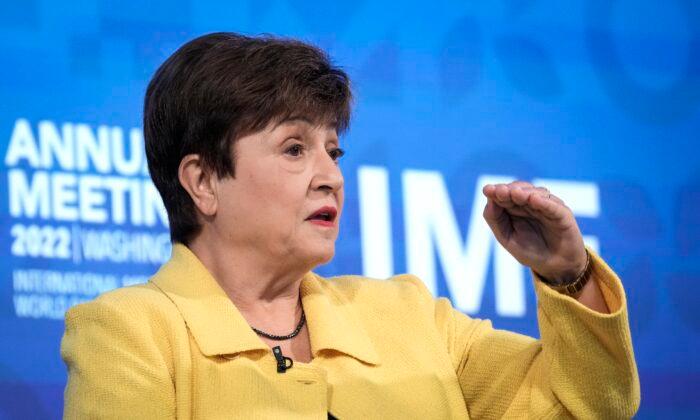The development of central bank digital currencies (CBDC) could potentially replace cash, although widespread adoption will take time, International Monetary Fund (IMF) Director Kristalina Georgieva says.
While appearing at the Singapore FinTech Festival on Nov. 15, the IMF chief championed the benefits of digital currencies, saying that they can bolster “financial inclusion.”
“CBDCs can replace cash, which is costly to distribute in island economies. They can offer resilience in more advanced economies. And they can improve financial inclusion where few hold bank accounts,” Ms. Georgieva said in a speech. “CBDCs would offer a safe and low-cost alternative to cash. They would also offer a bridge to go between private monies and a yardstick to measure their value, just like cash today, which we can withdraw from our banks.”
Ms. Georgieva believes artificial intelligence could play an integral role in advancing the advantages of digital currencies, such as offering accurate credit scoring, providing personalized support, and avoiding biases to prevent inequality.
Her remarks came the same day that the IMF published a paper offering “initial guidance” to policymakers on studying, designing, and implementing a CBDC. The paper states that these virtual currencies could improve payment systems if governments “appropriately” create CBDCs.
“Given the complexities and the novelty involved, policymakers need to explore CBDC carefully and systematically,” the paper’s authors said.
Last year, the IMF also published a comprehensive report that cited the “unprecedented” level of international interest in CBDCs. The 2022 IMF report highlighted a Bank for International Settlements survey in 2022 that confirmed that 93 percent of central banks are studying CBDCs, with financial inclusion in emerging and low-income economies as the “key policy objective.”
Across the globe, governments and central banks have started experimenting or researching the digitization of their currencies. So far, nearly a dozen countries have launched CBDCs, and 100 are in the pilot, development, or research phase, according to the Atlantic Council’s CBDC tracker tool.
Pushback in Washington
In the Republican-led U.S. House of Representatives, there has been growing pushback against CBDCs.The House Financial Services Committee, for example, recently approved the CBDC Anti-Surveillance State Act (H.R. 5403), a bill that restricts the Federal Reserve from issuing a CBDC directly or indirectly to individuals.
Rep. Tom Emmer (R-Minn.), the legislation’s author, took to the House floor on Sept. 20 to champion the bill.
“In short, a central bank digital currency is government-controlled programmable money that, if not designed to emulate cash, could give the federal government the ability to surveil and restrict Americans’ transactions,” he said.
The House majority whip’s bill has 60 Republican co-sponsors.
This past spring, Mr. Emmer accused President Joe Biden and his administration of trying to manufacture an “authoritarian-style” and “surveillance-style” digital dollar through executive orders.
“The consequences, if we get it wrong, are far too serious,” he told reporters in February. “The Biden administration is currently itching to create a digital authoritarian-style, surveillance-style digital dollar through an executive order.”
Others also have expressed concerns that a digital dollar could threaten Americans’ privacy.
In multiple speeches this year, Fed Governor Michelle Bowman revealed that she thought adopting a digital dollar “could pose significant risks and trade-offs for the financial system.”
“These risks and trade-offs include potential unintended consequences for the U.S. banking system and considerable consumer privacy concerns,” Ms. Bowman told the Harvard Law School Program on International Financial Systems roundtable last month.
The Federal Reserve has stated that it’s still in the research phase of CBDCs.
Michael S. Barr, the Fed vice chair for supervision, told lawmakers during a Nov. 15 House Financial Services Committee hearing that the central bank hasn’t “made any decision at all” about issuing a retail CBDC.
Mixed Interest
This past spring, the Cato Institute released the results of its 2023 CBDC national survey. It found that only 16 percent of Americans support the adoption of a CBDC, while 34 percent oppose the Fed issuing a digital dollar. The poll also revealed that 76 percent of respondents are more concerned about the possible risks than potential benefits.For countries that have launched CBDCs, the authorities have been discouraged by the paucity of usage.
In October 2021, the Central Bank of Nigeria launched the Naira, Africa’s first CBDC. IMF research has found that 98.5 percent of eNaira digital wallets aren’t used, prompting the Nigerian government to redesign the currency and make adjustments to foster greater adoption, such as removing access restrictions and providing discounts for taxi services. Officials also restricted cash withdrawals to facilitate more significant CBDC usage.
Chinese consumers, too, haven’t been enthusiastic about the digital yuan, despite the regime accelerating its presence in domestic and cross-border transactions. China has used various strategies to foster adoption, from launching lotteries to pressuring merchants to accept digital yuan.
It’s estimated that the digital yuan accounts for 0.2 percent of the nation’s money supply.
However, Chinese officials are doubling down on the digital yuan, insisting that CBDC’s “programmable features” could improve the effectiveness of the monetary policy tools used by the People’s Bank of China.
Lu Lei, the deputy administrator of the State Administration of Foreign Exchange, told a forum last month that policymakers could test out different features to manage the macroeconomy. This could consist of programming money to have expiration dates, restricting digital money for specific transactions, and altering CBDC rates.
Last month, oil and gas company PetroChina settled the world’s first international crude oil transaction using the digital yuan. The firm purchased 1 million barrels of crude oil on the Shanghai Petroleum and Natural Gas Exchange with the e-CNY.
Meanwhile, several major countries have initiated CBDC pilot projects this year, including Russia, Japan, Singapore, Switzerland, and India.







